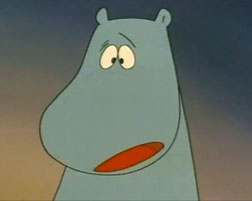
No matter what, there will always be shows that are “troubled productions”. Problems can be for many reasons, but usually the biggest issues are over “content”. This is what happened with the 1969 Moomin anime produced for TV.
Moomin originated in Finland back in 1945, created by Tove Jansson (1914-2001). Moomin is a troll with a roundish nose, resembling a hippopotamus. Moomin lives with Moominpappa and Moominmamma in Moominvalley. He is close friends with Snork Maiden, an energetic girl who likes to have fun. She lives with her older brother Snork, an introverted genius who is seen inventing things. Little My is a young girl who lives to get into mischief. Often times, Moomin goes to Snufkin, a quiet traveler for advice. He is often seen carrying a lute.
Tove Jansson wrote over nine books with the character. In addition, she also drew a newspaper comic strip, written in English, for The Evening News newspaper in London, starting 1954. Tove Jansson initially did the strip herself, but starting in 1957 she enlisted her brother, Lars, for help. Lars took over the strip full time in 1960, drawing until its end in 1975.

There has been many screen adaptations of the series all over the world, including Japan. In 1969, Zuiyo Enterprise bought the rights for the Moomin anime, set to air as part of Calpis Comic Theater, a television block that aired Sunday nights on Fuji Television, sponsored by Calpis, a Japanese soft-drink brand (it later became World Masterpiece Theater, airing anime adaptations of popular classical books from around the world, lasting until 1997).
Zuiyo contracted Tokyo Movie Shinsha (TMS) to produce the anime, working with A Production on the series. Masaaki Osumi (born 1934) was assigned to direct the show. For American anime fans, Osumi is known for his ill-fated stint on Tokyo Movie’s first Lupin the 3rd anime, where he was fired from the show in the middle of the run in an effort to save the show. It wasn’t looking good for him on this earlier series either.
 Moomin was always a gentle series. The tone is very eccentric, but gentleness was always a big theme. Part of the appeal was seeing how the characters handle weird situations in a gentle way. However, when Tokyo Movie got the series, it went through what today would be considered the “darker and edgier” syndrome. Under Osumi’s direction, Moomin acted like a typical Japanese boy, getting into fights and general mischievousness. Snork Maiden (called “Non Non” in Japan), while always a bit vain in the original stories, but it was pushed further in the 1969 series. Her brother Snork was shown as an egotistical jerk who looked down on Moomin and others. He was also seen driving a car, something that was never present in the original stories. One episode featured characters getting drunk at a bar; no alcohol was present in the original stories.
Moomin was always a gentle series. The tone is very eccentric, but gentleness was always a big theme. Part of the appeal was seeing how the characters handle weird situations in a gentle way. However, when Tokyo Movie got the series, it went through what today would be considered the “darker and edgier” syndrome. Under Osumi’s direction, Moomin acted like a typical Japanese boy, getting into fights and general mischievousness. Snork Maiden (called “Non Non” in Japan), while always a bit vain in the original stories, but it was pushed further in the 1969 series. Her brother Snork was shown as an egotistical jerk who looked down on Moomin and others. He was also seen driving a car, something that was never present in the original stories. One episode featured characters getting drunk at a bar; no alcohol was present in the original stories.
To say that Tove Jansson was “displeased” would be an understatement. She ordered that TMS be removed from the show. Zuiyo fired TMS and switched to Mushi Production. Originally founded by Osamu Tezuka, Mushi started with the idea that it would produce shows based on Tezuka’s manga, such as Astro Boy, Kimba the White Lion, and Amazing 3. However, by the time they got Moomin, Tezuka has left the company and the studio began producing shows created by other people.
 At Mushi Production, Rintaro (real name: Shigeyuki Hayashi, born 1941) took over as the series director. Under his direction, he pushed to give the show a tone that was more close to the original series. There was no longer any fighting, cars, alcohol present when TMS had the show. It is unclear what Tove thought of this version of the anime, but presumably she was happier with them than what TMS did.
At Mushi Production, Rintaro (real name: Shigeyuki Hayashi, born 1941) took over as the series director. Under his direction, he pushed to give the show a tone that was more close to the original series. There was no longer any fighting, cars, alcohol present when TMS had the show. It is unclear what Tove thought of this version of the anime, but presumably she was happier with them than what TMS did.
That is not to say that the TMS episodes are bad. Masaaki Osumi, despite getting fired from two different shows at TMS within two years, was a good director, and his Moomin episodes are well done with good direction, emotional weight for characters, and stories that are well-done. Rintaro’s early episodes were rough, with simpler layouts and stilted character designs (trying to ape the TMS design while still different in tone), but after a while he got the hang of it and went on to do good work.
The first Moomin anime ran for 65 episodes from October 5th, 1969 to December 27th, 1970. TMS did the first 26 episodes, with Mushi doing the rest. However, the franchise remained popular enough to warrant a second series, so Mushi Production produced 52 more episodes to air from January 9 to December 31, 1972. Rintaro, again, supervised this show. For the 1972 series the character designs were changed to be more rounder and cuter. Moomin was given a bigger, somewhat animesque eyes, his snout became smaller, and be became shorter.
Both series continued to air in reruns over the years. The 1972 series was released on VHS tapes once they became available, a staple in retail stores. But bigger things was yet to come with the unsuspecting Japanese public. In 1990, a new anime was made, called Tanoshii Moomin Ikka (“Delightful Moomin Family”). Produced by Telescreen, this new show aired for 104 episodes on TV Tokyo from 1990 to 1992. This new show helped ignite a “Moomin Boom” in Japan, where the public became obsessed with the character – with plush toys, books, and other merchandise becoming best sellers. In Tokyo you can go to “Moomin Shop”. Opened in 2012, you can buy items bearing Moomin characters, as well as a coffee corner where you can order lattes with Moomin characters drawn on top of the foam with cocoa powder. If you’re ever in the city, go check it out. It’s located at Dogwood Plaza in Futakotamagawa, on the second floor.
So which studio did Moomin better? Below are two episodes, the first from TMS and the second from Mushi.
TMS episode (1969)
MUSHI episode (1972)
Post Script: The best is apparently yet to come for the Moomins. This Fall Moomins On The Riviera directed by Xavier Picard and produced in Paris by Handle Productions and Pictak, will be released to theaters in Europe and Japan.


 Charles Brubaker is a cartoonist originally from Japan. In addition to his work for MAD Magazine and SpongeBob Comics, he also created Ask a Cat for GoComics. You can also follow him on his Tumblr page.
Charles Brubaker is a cartoonist originally from Japan. In addition to his work for MAD Magazine and SpongeBob Comics, he also created Ask a Cat for GoComics. You can also follow him on his Tumblr page.











































A popular drink with a rather unfortunate-sounding name (at least to the anglo-speaking world).
It certainly seemed like the show was no different from the sort of gag manga present at the time. Certainly did fit with what Jansson’s creation was about (they copied the look but not the substance I suppose you could say). They amost screwed it up permanently if it not for the studio switch (we may never have had anymore adaptations of Moonins grace our screens in the later decades).
While I’m not sure what distribution outside Japan there was for the original shows, the 90’s series did see airplay in many countries (though not the US sadly). Though not included here anyway, here’s the first episode to check out!
https://www.youtube.com/watch?v=MUimRPULBKU
And like the rest, I’m sure it’ll pass us by too (at last we have the books in print here, that’s something).
Just to give a bit of further explanation to the post above about other versions: another adaptation of the Moomins stories was a stop motion version, produced by a European animation studio and broadcast on ITV, a commercial channel in the UK during the 1980s and narrated by actor Richard Murdoch. I have seen this referred to as the ” Fuzzy Felt” Moomins. This version is much softer-it can be found on YouTube-and far preferable to a Japanese version that was on the BBC during the 1990s.
You could hardly call this a history on animated Moomin when you left out the 1990’series and the stop motion! They both have English language versions and the 90s show is easily seen on YouTube, too boot.
The best adaptation of the Moomins is, of course, the 1977-1982 Polish series “Opowiadania Muminków”.
Its scripts were cowritten by Tove Jansson herself. She personally supervised this series and said that it was the best and most spiritually true adaptation of the Moomins that anyone has ever made. It also received an uncut German dubbing.
The cartoon was later imported to the United Kingdom and badly changed. The names of the original creators were removed and replaced with the name of an Englishman who imported it. The importer edited the cartoon and cut it down by 4 hours.